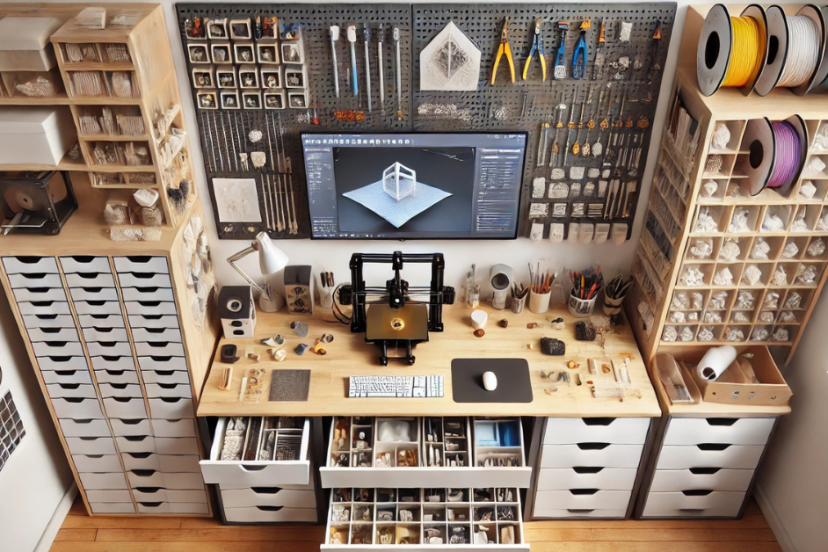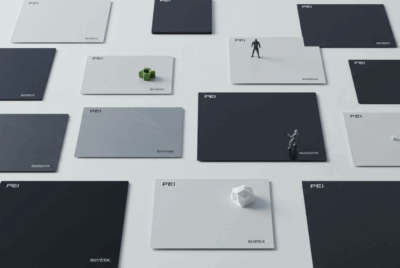Top 10 Innovative 3D Printer Storage Ideas for Small Spaces
Have you ever felt overwhelmed by the clutter of your 3D printing equipment in your cozy workspace? Fear not! In this article, we’ll dive into the top 10 innovative 3D printer storage ideas specifically designed for small spaces. Whether you’re a hobbyist or a professional, these tips will help you maximize your area while keeping your 3D printing gear organized and accessible.
Understanding Space Constraints
Why is Efficient Storage Crucial for 3D Printing Enthusiasts?
For 3D printing aficionados, managing a small workspace is like playing a strategic game of Tetris.
You need to fit all your essential gear – the printer, filaments, tools, and prints – into a limited area without sacrificing functionality or your own comfort. This challenge is not just about aesthetics; it’s about creating a workflow that is both efficient and inspiring.
The Impact of Clutter on Productivity and Creativity
Let’s face it, clutter isn’t just an eyesore; it’s a creativity killer. A cramped and disorganized space can lead to increased stress, reduced focus, and a drop in productivity. When every tool and material has its designated spot, you spend less time searching and more time creating. The key is to understand the unique demands of 3D printing and how they interact with the spatial limitations of your environment.
Maximizing Your Space: Thinking Beyond the Printer
Often, the focus is solely on the printer, but what about the spools of filament, the various tools, and the finished prints? These items can take up more space than the printer itself! We’ll delve into how to consider each component of your 3D printing setup in your storage plan.
Adapting to Your Environment: Storage Solutions That Fit Your Space
Every space is unique, be it a tiny corner in your living room or a small dedicated office. Adapting your storage solutions to the specific contours of your space is crucial. We’ll explore how custom solutions can be more effective than one-size-fits-all options.
The Psychology of Space: Creating a Workspace That Inspires
Lastly, it’s important to consider how your environment affects your mindset. A well-organized space isn’t just about efficiency; it’s about creating an area that inspires innovation and creativity. We’ll touch on how the right storage solutions can positively impact your mental space and fuel your passion for 3D printing.
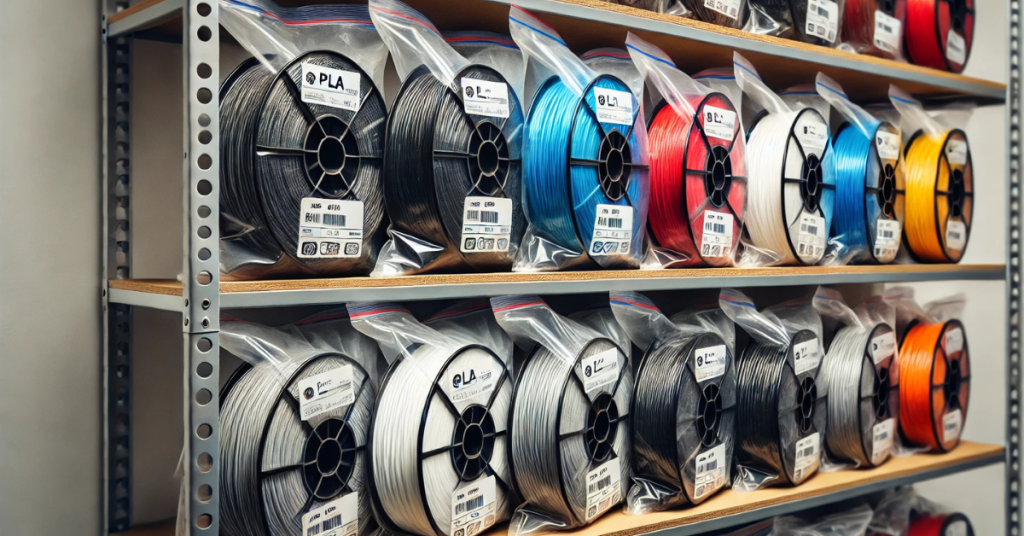
Vertical Storage Solutions
The Sky’s the Limit: Going Vertical with Your 3D Printer Storage
In the quest for efficient 3D printer storage in small spaces, the answer often lies not around you, but above you. Vertical storage solutions are a game-changer, offering a plethora of options to declutter and organize your workspace without compromising floor space.
Wall-Mounted Shelves: Elevating Your Storage Game
Imagine transforming your walls into a functional storage display. Wall-mounted shelves are not just about saving space; they are about optimizing it. Perfect for holding printers, filament rolls, and tools, these shelves keep everything visible and within arm’s reach. We’ll explore various shelving options – from floating shelves to modular systems – that can be tailored to the size and weight of your 3D printing equipment.
Pegboards: The Ultimate Customizable Solution
Pegboards are a versatile and visually appealing way to organize your 3D printing accessories. With a pegboard, the possibilities are endless – hooks for hanging tools, small shelves for your filaments, and even clips for holding your design blueprints. They’re not just functional; they add an aesthetic touch to your workspace, allowing you to see all your tools at a glance.
Vertical Drawer Systems: Compact and Efficient
For those who prefer a more discreet storage solution, vertical drawer systems offer compact efficiency. These drawers can be slim enough to fit in narrow spaces, yet spacious enough to house your printing materials and tools. We’ll discuss how to choose the right drawer system and organize it effectively to maximize your storage potential.
Utilizing Vertical Space in Unexpected Places
Finally, we should not overlook unconventional areas for vertical storage. The back of a door, the side of a desk, or even the space between furniture can be transformed into smart storage solutions. We’ll provide creative ideas on how to utilize these often-overlooked spaces to create additional storage for your 3D printing needs.
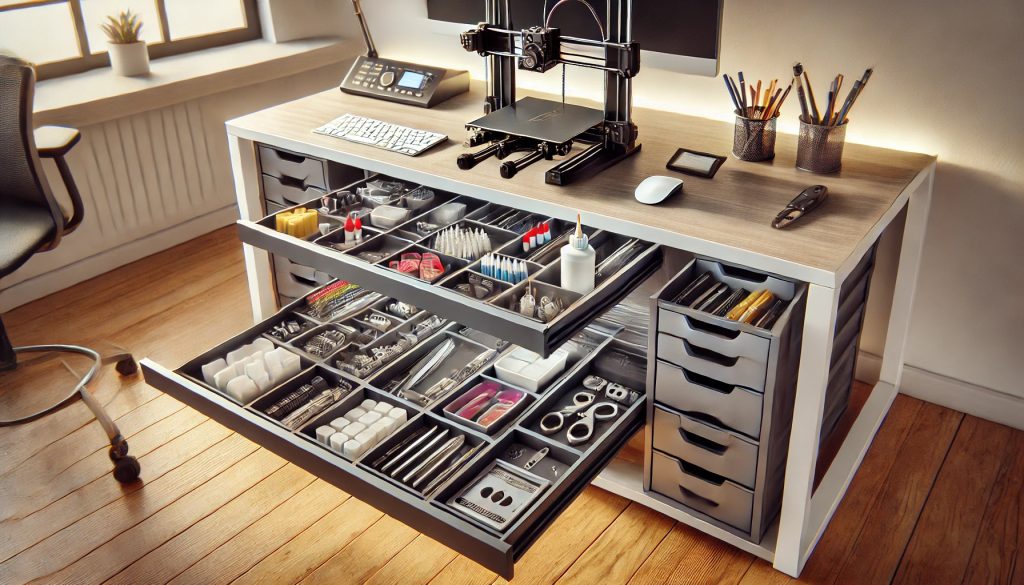
Under-the-Desk Hacks
Hidden Gems: The Art of Under-the-Desk Storage
Often overlooked, the space under your desk is a hidden treasure trove for innovative storage solutions. With the right approach, this area can become a key component in your 3D printing workspace, especially in small rooms or shared spaces.
Slide-Out Trays and Drawers: Out of Sight, But in Reach
Imagine having all your frequently used tools and small materials neatly stored in slide-out trays or drawers under your desk. These solutions not only keep your items organized and out of sight but also ensure they are easily accessible when you’re in the middle of a project. We’ll explore options for installing custom slide-out storage or repurposing existing desk drawers.
Rolling Carts: Mobile and Multipurpose
Rolling carts are a fantastic under-desk storage solution. They can be easily moved in and out as needed, providing flexible storage for filament spools, tools, and even small 3D printers. Plus, their mobility means you can reposition them to wherever you’re working, making them highly practical for dynamic workspaces.
Utilizing Bins and Containers for Organized Chaos
Small bins and containers can be a simple yet effective way to utilize under-desk space. They’re great for storing a variety of items, from spare parts to finished pieces, and can be labeled for easy identification. This section will delve into how to best utilize these containers to minimize clutter and maximize efficiency.
Innovative Custom Solutions: Tailoring to Your Specific Needs
Lastly, there’s always room for innovation. We’ll inspire you with ideas for custom-built solutions that perfectly fit the dimensions and specific needs of your under-desk space. Whether it’s a bespoke rack for filament spools or a custom shelf for your tools, these tailored solutions can make a world of difference in small spaces.
Innovative Cabinet Designs
Custom Cabinets: Tailoring Storage to Your Space
When it comes to storing 3D printers and their accessories, one size doesn’t fit all. This is where custom cabinets come into play, offering tailored solutions that perfectly fit your space and storage needs. In this section, we’ll explore the world of custom cabinet designs, from built-in units that maximize every inch of available space to standalone pieces that are both functional and stylish.
Features of a Perfect 3D Printer Cabinet
What makes a cabinet ideal for 3D printer storage? It’s not just about size; it’s about functionality. We’ll discuss key features such as ventilation for printers in use, built-in electrical outlets for easy power access, and specialized compartments for filament and tools. These features ensure your cabinet is not just a storage unit, but a fully functional 3D printing station.
Combining Aesthetics with Functionality
Your cabinet doesn’t have to be purely utilitarian. This section will delve into how you can choose materials, colors, and designs that not only serve your storage needs but also complement your room’s decor. Whether you prefer a modern, sleek look or a more traditional aesthetic, your cabinet can be both a storage solution and a statement piece.
Space-Saving Cabinet Ideas for Tiny Workspaces
For those with particularly small workspaces, we’ll provide creative cabinet ideas that make the most of limited space. Think vertically with tall, narrow cabinets, or consider designs that fit snugly into corners or under desks. These innovative solutions show that even the smallest spaces can be efficiently organized without sacrificing style.
DIY Cabinet Solutions for the Hands-On Enthusiast
For the DIY enthusiast, there’s nothing more satisfying than building your own storage solution. We’ll offer guidance on designing and constructing your own 3D printer cabinet, including material recommendations, construction tips, and customization ideas. This way, you can create a storage solution that’s perfectly suited to your specific needs and skills.
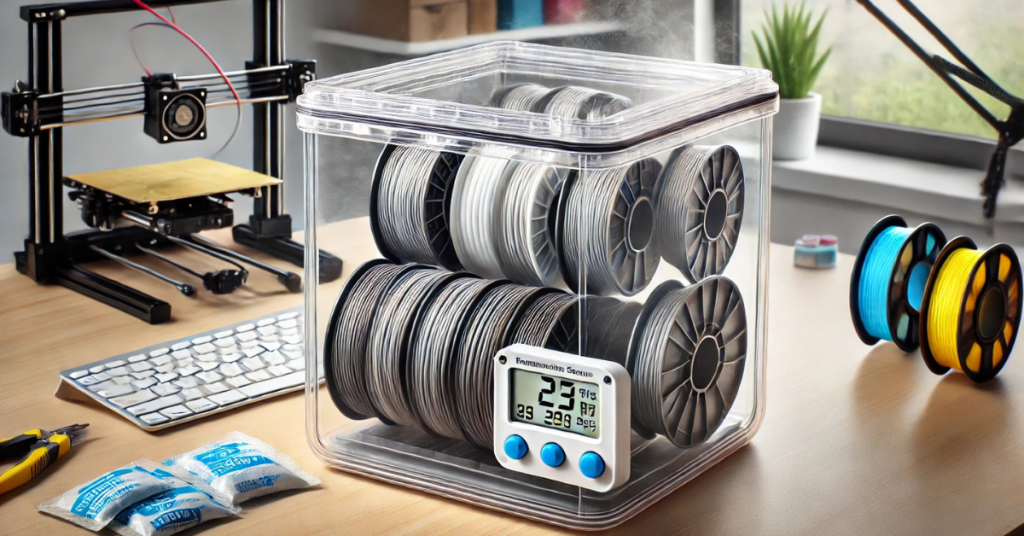
Stackable Containers
Maximizing Space with Stackable Storage Solutions
In the world of small-space organization, stackable containers are a must-have. They offer a versatile and space-efficient way to store and organize everything from filament spools to finished prints and tools. This section will guide you through the best practices for using stackable containers to their fullest potential in your 3D printing workspace.
Choosing the Right Containers for Your Needs
Not all stackable containers are created equal. We’ll delve into what to look for when selecting containers for your 3D printing supplies. Factors like size, durability, and material are important to consider. Transparent containers, for example, allow you to easily see their contents, while stackable bins with drawers provide easy access to items even when the bins are stacked.
Organizing Filaments and Tools in Stackable Containers
Filaments and tools can quickly become disorganized, making your 3D printing process less efficient. We’ll discuss how to categorize and store different types of filaments and tools in stackable containers. This includes tips on preventing filament tangling and damage, as well as organizing tools for easy accessibility.
Labeling and Categorization for Easy Access
A key advantage of using stackable containers is the ability to label and categorize your supplies. We’ll cover techniques for effective labeling and categorization, ensuring that you can always find what you need quickly. Whether it’s color-coding or detailed labeling, these strategies are crucial for maintaining an organized workspace.
Creative Stacking Strategies for Small Spaces
Finally, we’ll explore creative ways to stack containers to make the most of your available space.
This includes innovative ideas like vertical stacking in unused corners, under-desk storage, or even hanging stackable bins on walls or the side of a desk. We’ll provide you with practical and imaginative stacking strategies to optimize your storage area.
Utilizing Closet Space
Transforming Closets into Efficient Storage Areas
In the search for effective 3D printer storage solutions, closets present a unique opportunity.
Often underused, closets can be transformed into highly efficient storage areas for your 3D printing equipment and supplies. This section will guide you through the process of converting an ordinary closet into a well-organized, functional storage space for your 3D printing needs.
Assessing Your Closet Space for 3D Printing Storage
The first step in utilizing closet space is to assess its potential. We’ll discuss how to measure and evaluate your closet space, considering factors such as depth, height, and accessibility. Understanding the dimensions and layout of your closet is crucial for planning an effective storage setup.
Shelving and Racking Solutions for Closets
Shelves and racks can greatly enhance the storage capacity of a closet. We’ll explore various shelving options, from wire racks that allow for visibility and ventilation to wooden shelves that can be custom-fitted to your closet’s dimensions. These solutions can help in neatly organizing everything from filament spools to finished projects and tools.
Making the Most of Vertical Space in Closets
Closets often have ample vertical space that can be optimized. We’ll provide tips on utilizing the full height of your closet, including ideas for high shelves for rarely used items, hanging solutions for tools and supplies, and even adding a second closet rod or hooks for additional hanging storage.
Incorporating Drawers and Bins for Small Items
For smaller items and components, drawers and bins within a closet can be extremely useful. We’ll discuss how to integrate these into your closet space, whether through built-in drawers, stackable bins, or hanging organizers. This section will focus on how to categorize and label these storage compartments for easy retrieval of items.
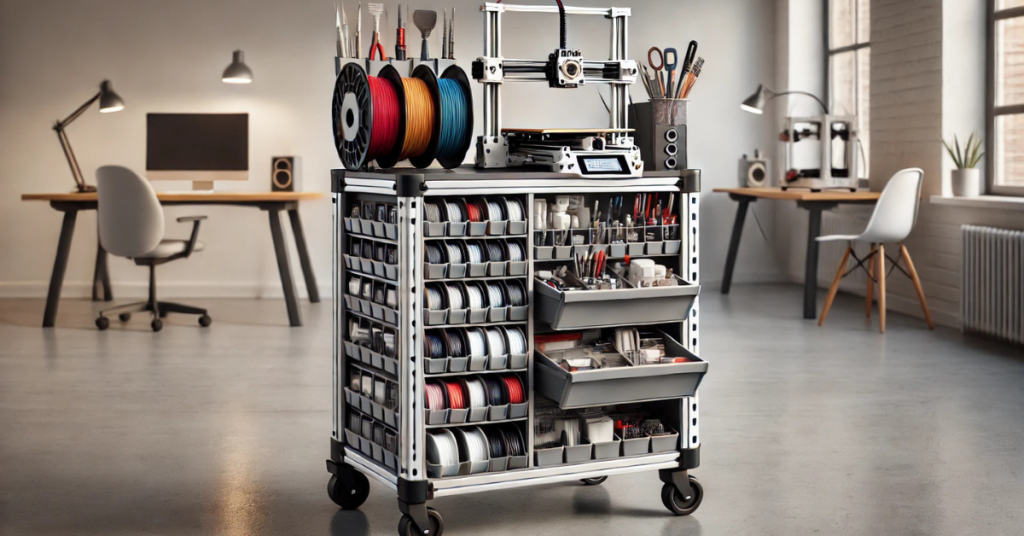
Mobile Storage Carts
The Versatility of Mobile Storage Carts in 3D Printing
Mobile storage carts are a dynamic and flexible solution for 3D printer enthusiasts, particularly in small or multi-use spaces. These carts offer the convenience of moving your supplies and equipment exactly where you need them, making them an ideal choice for those who value flexibility and efficiency in their workspace.
Selecting the Right Mobile Cart for Your Needs
Choosing the right mobile cart is key. We’ll cover what to look for in a mobile storage cart, including size, material, weight capacity, and the type of casters for smooth movement. Whether you need a cart with multiple shelves for different materials or one with locking wheels for stability, this section will guide you in making the best choice for your workspace.
Organizing Your Cart for Maximum Efficiency
An organized mobile cart can significantly enhance your 3D printing process. We’ll discuss how to best organize your cart, from arranging tools and filaments to allocating space for in-progress and completed projects. This includes tips on using dividers, bins, and holders to keep everything in place while the cart is in motion.
Multi-functional Carts: Beyond Just Storage
Mobile carts don’t have to be solely for storage; they can serve multiple purposes. We’ll explore ideas for turning your mobile cart into a multi-functional unit, such as adding a tabletop for additional working space or incorporating a charging station for your electronic devices and tools.
DIY Mobile Cart Customizations
For the DIY enthusiast, customizing a mobile cart can be a rewarding project. We’ll provide inspiration and tips for modifying and personalizing your mobile cart, from painting and decorating to adding custom hooks and holders tailored to your specific tools and equipment.
Foldable and Retractable Surfaces
Space-Saving Magic: Foldable and Retractable Surfaces for 3D Printing
In the quest to maximize small spaces, foldable and retractable surfaces emerge as innovative solutions. These versatile surfaces can provide the much-needed workspace when you’re 3D printing and conveniently tuck away when not in use, offering a perfect blend of functionality and space efficiency.
The Appeal of Foldable Desks and Workbenches
Foldable desks and workbenches are ideal for small or multi-purpose rooms. We’ll explore various designs, from wall-mounted drop-leaf tables to foldable workbenches, and discuss their benefits in a 3D printing setup. This includes considerations like weight capacity, surface area, and ease of folding and unfolding.
Retractable Surfaces for Multi-Use Spaces
Retractable surfaces, such as pull-out shelves or slide-away countertops, can transform any area into a temporary 3D printing station. We’ll provide insights into how these surfaces can be integrated into existing furniture, like cabinets or shelves, offering a hidden yet accessible workspace.
DIY Solutions: Creating Your Own Foldable Surfaces
For those who love to create and customize, DIY foldable and retractable surfaces can be a rewarding project. We’ll offer guidance on building your own, including materials, tools, and design plans. This section aims to inspire with creative ideas that cater to different skill levels and space constraints.
Optimizing Space with Cleverly Designed Furniture
Finally, we’ll explore cleverly designed furniture that combines storage and foldable surfaces. Think of a cabinet that opens up into a full workbench or a bookshelf with a pull-down table. These dual-purpose pieces are not only space-savers but also add a unique aesthetic to your workspace.
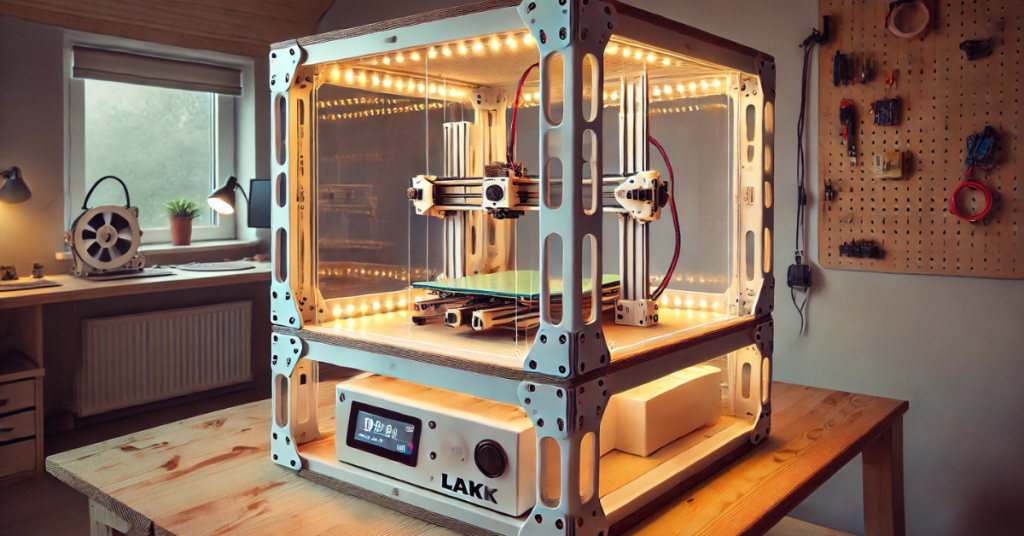
Creative DIY Solutions
Unleashing Creativity: DIY Storage Ideas for 3D Printers
For those who love to tinker, customize, and create, DIY solutions offer endless possibilities to design storage that perfectly fits your specific 3D printing needs and space. This section is all about inspiring you to build your own storage solutions, turning your workspace into a reflection of your creativity and ingenuity.
Building Your Own 3D Printer Stand
Let’s start with a fundamental piece: a DIY 3D printer stand. We’ll walk through the process of designing and building a stand that not only holds your printer but also includes storage for tools and materials. This includes tips on selecting materials, ensuring stability and ventilation, and customizing the stand to fit your printer’s dimensions.
Custom Filament Storage Solutions
Proper filament storage is key to successful 3D printing. Here, we’ll delve into how to create DIY storage solutions that protect your filaments from moisture and dust. From simple wall-mounted racks to vacuum-sealed containers with humidity control, this section will cover a range of ideas to suit various storage needs and spaces.
Repurposing and Upcycling for Storage
In the spirit of creativity and sustainability, this part will focus on repurposing and upcycling items into storage solutions. Think converting old furniture into printer stands, using discarded containers for small parts, or transforming household items into tool organizers. We’ll provide inspiration for turning everyday objects into functional storage for your 3D printing supplies.
Integrating Tech and Storage
For the tech-savvy DIYer, integrating technology into your storage solutions can add functionality and convenience. This could include adding LED lighting to shelves, incorporating a charging station in your printer stand, or even building a small, computer-controlled inventory system for
your materials. We’ll explore some tech-integrated storage ideas that you can create.
Multi-functional Furniture
Doubling the Functionality: Furniture That Serves More Than One Purpose
In the realm of small-space living and efficient workspaces, multi-functional furniture is a true game-changer. These innovative pieces serve dual purposes, combining storage and functionality in a way that maximizes space without sacrificing style or efficiency. This section is dedicated to exploring how multi-functional furniture can revolutionize your 3D printing area.
Desk-Bed Combos for Ultra-Compact Spaces
A desk that transforms into a bed (or vice versa) can be an excellent solution for extremely limited spaces. Here, we’ll look at how these combo pieces work, what to consider when choosing one, and how they can be integrated into a small workspace without disrupting your 3D printing setup.
Storage Ottomans: Seating Plus Storage
Storage ottomans are a perfect example of multi-functional furniture. Not only do they provide a seating option, but they also offer a hidden storage compartment. We’ll discuss how to use these ottomans to store smaller 3D printing tools and materials, keeping them accessible yet out of sight.
Fold-Out Workstations in Cabinets
For those who need to completely conceal their workspace at times, a fold-out workstation housed within a cabinet can be the ideal solution. This section will cover the design and functionality of these workstations, including how they can be used to store a 3D printer and accessories, and then be neatly folded away when not in use.
Customizing Existing Furniture for Dual Purposes
Lastly, we’ll offer ideas on how to modify existing furniture to serve dual purposes. This could involve adding a slide-out surface to a bookshelf for additional workspace or retrofitting a wardrobe to house a 3D printer and its supplies. We’ll provide tips and inspiration for these DIY customization projects.
Safety Considerations
Prioritizing Safety in Your 3D Printer Storage Design
When designing storage solutions for 3D printers and their accessories, safety should be a primary concern. This section addresses the key safety considerations to keep in mind, ensuring that your workspace is not only efficient and organized but also safe for use.
Ventilation: A Must for 3D Printer Storage
Proper ventilation is crucial, especially when storing 3D printers that are in use. We’ll discuss the importance of adequate airflow to prevent overheating and to dispel any potentially harmful fumes, particularly for printers that use materials like ABS plastic. This includes tips on how to design or choose storage solutions with ventilation in mind.
Fire Safety Measures
3D printers, like any electronic equipment, pose a fire risk. In this part, we’ll cover essential fire safety measures, such as using flame-retardant materials in storage construction, ensuring easy access to fire extinguishers, and incorporating smoke detectors in areas where printers are stored and operated.
Secure Storage for Hazardous Materials
Certain 3D printing materials and solvents can be hazardous if not stored properly. We’ll guide you through the best practices for storing these materials safely, including using lockable cabinets, proper labeling, and adhering to any specific storage guidelines for particular substances.
Child and Pet Safety in Your 3D Printing Area
For those with children or pets, ensuring the safety of your 3D printing area is paramount. This section will offer advice on creating a child- and pet-proof storage area, such as securing heavy items to prevent tipping, using child locks on cabinets, and keeping hazardous materials out of reach.
Maximizing Accessibility and Organization
Streamlining Your Space for Efficiency and Ease of Use
In any 3D printing workspace, especially those limited in size, the way you organize and access your tools and materials can significantly impact your efficiency and productivity. This section focuses on strategies to maximize both accessibility and organization, ensuring that everything you need is not only in its place but also easily within reach.
The Art of Strategic Placement
Strategic placement of items is key in a well-organized space. We’ll discuss how to position your 3D printer, tools, and materials in a way that aligns with your workflow. This includes tips on keeping frequently used items at arm’s length, and storing seldom-used items in less accessible spots.
Implementing an Effective Labeling System
An effective labeling system is crucial in a workspace where various types of tools and materials are used. We’ll provide insights into creating a labeling system that’s both easy to understand and maintain. Whether it’s color-coding or using clear, descriptive labels, this system can save you time and hassle.
Utilizing Organizational Accessories
There’s a wide array of organizational accessories available that can be game-changers in your 3D printing area. From drawer dividers to tool holders and filament organizers, we’ll explore various accessories that can help keep your space tidy and your items easy to find.
Ergonomics in the 3D Printing Workspace
Lastly, we’ll touch on the importance of ergonomics in your workspace organization. This includes arranging your space so that you can work comfortably without straining, and ensuring that all items are within a comfortable reach. We’ll cover how to set up your work area to promote good posture and reduce fatigue.
Wrapping Up: Embracing Efficiency and Creativity in Your 3D Printing Space
As we conclude our exploration of innovative 3D printer storage ideas for small spaces, it’s clear that efficiency and creativity go hand in hand. Whether you’re a seasoned 3D printing enthusiast or just starting out, the way you organize and store your equipment can have a profound impact on your experience and productivity. This guide aimed to provide you with practical and creative storage solutions, tailored to the unique challenges of small spaces.
Key Takeaways: What We’ve Learned
Let’s recap the key takeaways from our journey through optimizing 3D printing workspaces:
• Maximizing Small Spaces: Utilizing vertical storage, under-desk hacks, and foldable surfaces can significantly increase your workspace efficiency.
• Safety and Accessibility: Prioritizing safety in storage design and ensuring easy access to tools and materials are crucial for a smooth and enjoyable printing experience.
• DIY and Customization: Embracing DIY solutions and customizing your storage setup not only saves space but also adds a personal touch to your workspace.
• Multi-Functionality: Incorporating multi-functional furniture can dramatically change how space is used, offering flexibility and innovation in storage solutions.
Encouraging Continuous Improvement
Remember, organizing your 3D printing space is not a one-time task; it’s an ongoing process. As your collection of tools and materials grows and as new technologies emerge, your storage needs may evolve. We encourage you to continuously reassess and adapt your space to ensure it remains a place of creativity, efficiency, and safety.
Your Space, Your Rules
Ultimately, the best storage solution is one that suits your specific needs, preferences, and space constraints. We hope this guide has inspired you to look at your space with fresh eyes and to find creative, practical ways to organize and enhance your 3D printing experience.
FAQs
- How can I safely store my 3D printer in a small space?
Safety is paramount when storing a 3D printer. Ensure the space is well-ventilated, away from flammable materials, and that the printer is placed on a stable, heat-resistant surface. Consider using a cabinet with proper ventilation or a stand designed to handle the weight and heat output of your printer. - What are the best ways to store filament to avoid tangling and moisture?
To prevent tangling, use spool holders or racks that allow the filament to unwind smoothly. For moisture protection, store filaments in airtight containers with desiccants, or consider investing in a filament storage box that controls humidity. - Can I use vertical storage solutions even for heavier 3D printers?
Yes, but ensure the shelving or mounting system is sturdy enough to handle the weight. Wall-mounted shelves should be securely anchored to wall studs, and it’s advisable to consult with a professional to ensure safety. - Are there any specific considerations for storing resin 3D printers?
Yes. Resin printers require careful handling. Store resins in a cool, dark place, preferably in a cabinet to avoid light exposure. Ensure the storage area is well-ventilated and that protective gear is easily accessible. - How can I make my small 3D printing workspace child-proof?
Keep your 3D printer and materials out of reach, preferably in locked cabinets or shelves. Secure heavy objects to prevent tipping, use child-safe locks on drawers, and ensure that the printing area is supervised when in use.

